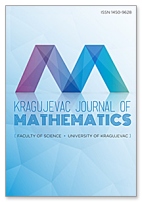Extended Convergence of a Two-Step-Secant-Type Method Under a Restricted Convergence Domain
 Download PDF
Download PDF
Authors: I. K. ARGYROS AND S. GEORGE
DOI: 10.46793/KgJMat2101.155A
Abstract:
We present a local as well as a semi-local convergence analysis of a two-step secant-type method for solving nonlinear equations involving Banach space valued operators. By using weakened Lipschitz and center Lipschitz conditions in combination with a more precise domain containing the iterates, we obtain tighter Lipschitz constants than in earlier studies. This technique lead to an extended convergence domain, more precise information on the location of the solution and tighter error bounds on the distances involved. These advantages are obtained under the same computational effort, since the new constants are special cases of the old ones used in earlier studies. The new technique can be used on other iterative methods. The numerical examples further illustrate the theoretical results.
Keywords:
Two step secant-type method, local convergence, Banach space, restricted convergence domain, divided difference.
References:
[1] I. K. Argyros, Y. J. Cho and S. Hilout, Numerical Methods for Equations and Its Applications, CRC Press, Boca Raton, London, New York, 2012.
[2] I. K. Argyros and H. Ren, On the convergence of efficient King-Werner-type methods of order 1 +  , J. Comput. Appl. Math. 38 (1982), 383–392.
, J. Comput. Appl. Math. 38 (1982), 383–392.
[3] I. K. Argyros, A. Cordero, A. Magreñán and J. R. Torregrosa, On the convergence of a damped Newton-like method with modified right hand side vector, Appl. Math. Comput. 266 (2015), 927–936.
[4] I. K. Argyros, S. George and N. Thapa, Mathematical Modeling for the Solution of Equations And Systems of Equations with Applications, 1, Nova Publishes, New York, 2018.
[5] I. K. Argyros, S. George and N. Thapa, Mathematical Modeling for the Solution of Equations and Systems of Equations with Applications, 2, Nova Publishes, New York, 2018.
[6] J. A. Ezquerro, M. Grau-Sánchez and M. A. Hernández, Solving non-differentiable equations by a new one-point iterative method with memory, J. Complexity 28 (2012), 48–58.
[7] J. A. Ezquerro and M. A. Hernández-Verón, Enlarging the domain of starting points for Newton’s method under center conditions on the first Frechet-derivative, J. Complexity 33 (2016), 89–106.
[8] J. M. Gutiérrez and M. A. Hernández, A family of Chebyshev-Halley type methods in Banach spaces, Bull. Aust. Math. Soc. 55 (1997), 113–130.
[9] M. Grau-Sánchez and M. Noguera, A technique to choose the most efficient method between secant method and some variants, Appl. Math. Comput. 218 (2012), 6415–6426.
[10] L. V. Kantrovich and G. P. Akilov, Functional Analysis, Pergamon Press, Oxford, 1982.
[11] A. Kumar, D. K. Gupta and S. Srivastava, Influence of the center condition on the two-step secant method, Int. J. Anal. 2017, Article ID 7364236, 9 pages, DOI 10.1155/2017/7364236.
[12] A. Kumar, D. K. Gupta, E. Martinez and S. Singh, Semilocal convergence of a secant-type method under weak Lipschitz conditions in Banach space, J. Comput. Appl. Math. 330 (2018), 732–741.
[13] A. A. Magreñán and I. K. Argyros, New improved convergence analysis for the secant method, Math. Comput. Simulation 119 (2016), 161–170.
[14] A. M. Ostrowski, Solution of Equations in Euclidean and Banach Spaces, Academic Press, New York, 1974.
[15] L. B. Rall, Computational Solution of Nonlinear Operator Equations, John Wiley and Sons, New Jersey, 1969.
[16] H. Ren and I. K. Argyros, On the convergence of efficient King-Werner-type methods of order 1+ free of derivative, Appl. Math. Comput. 256 (2015), 148–159.
free of derivative, Appl. Math. Comput. 256 (2015), 148–159.
[17] J. F. Traub, Iterative Methods for Solution of Equations, Printice-Hall, Englewood Cliffs, New Jersey, 1964.
[18] W. Werner, Some supplementary results on the 1 +  order method for the solution of nonlinear equations, Numer. Math. 38 (1982), 383–392.
order method for the solution of nonlinear equations, Numer. Math. 38 (1982), 383–392.
